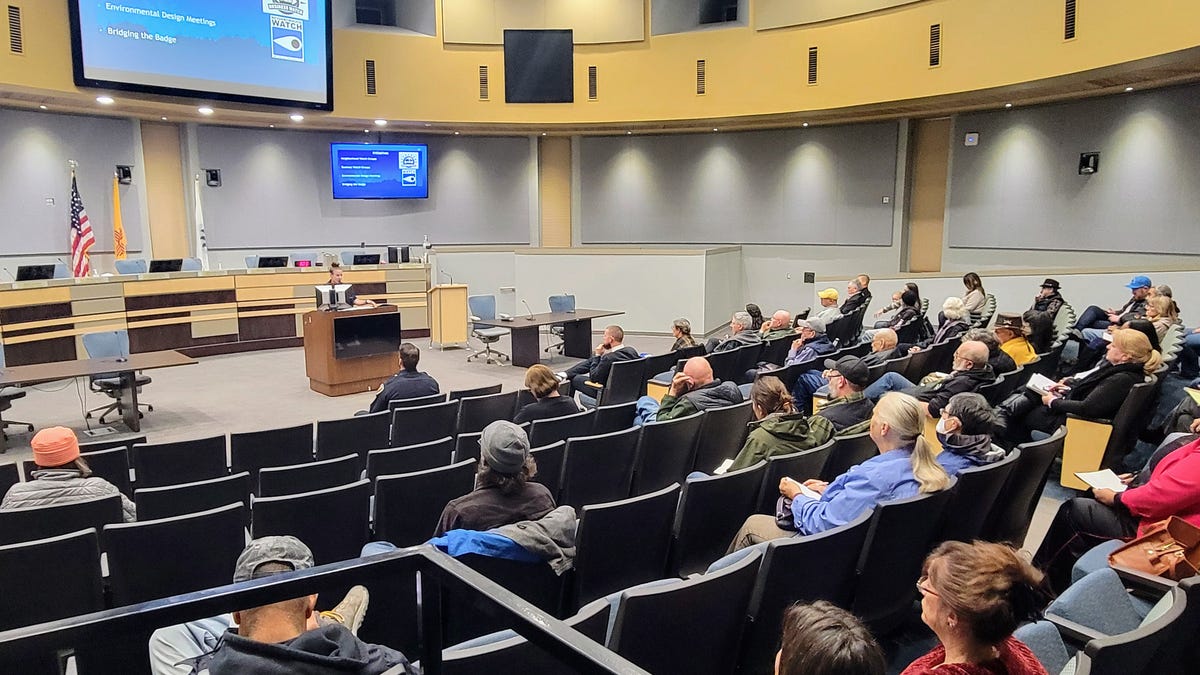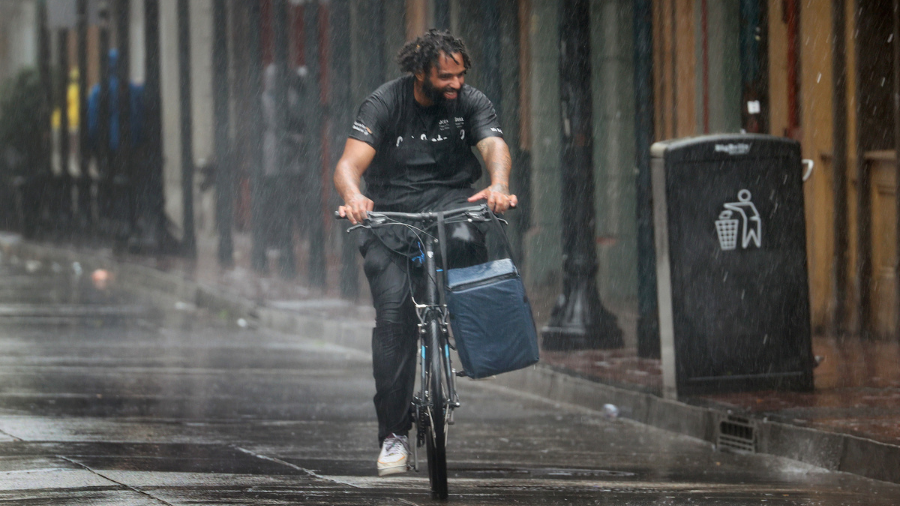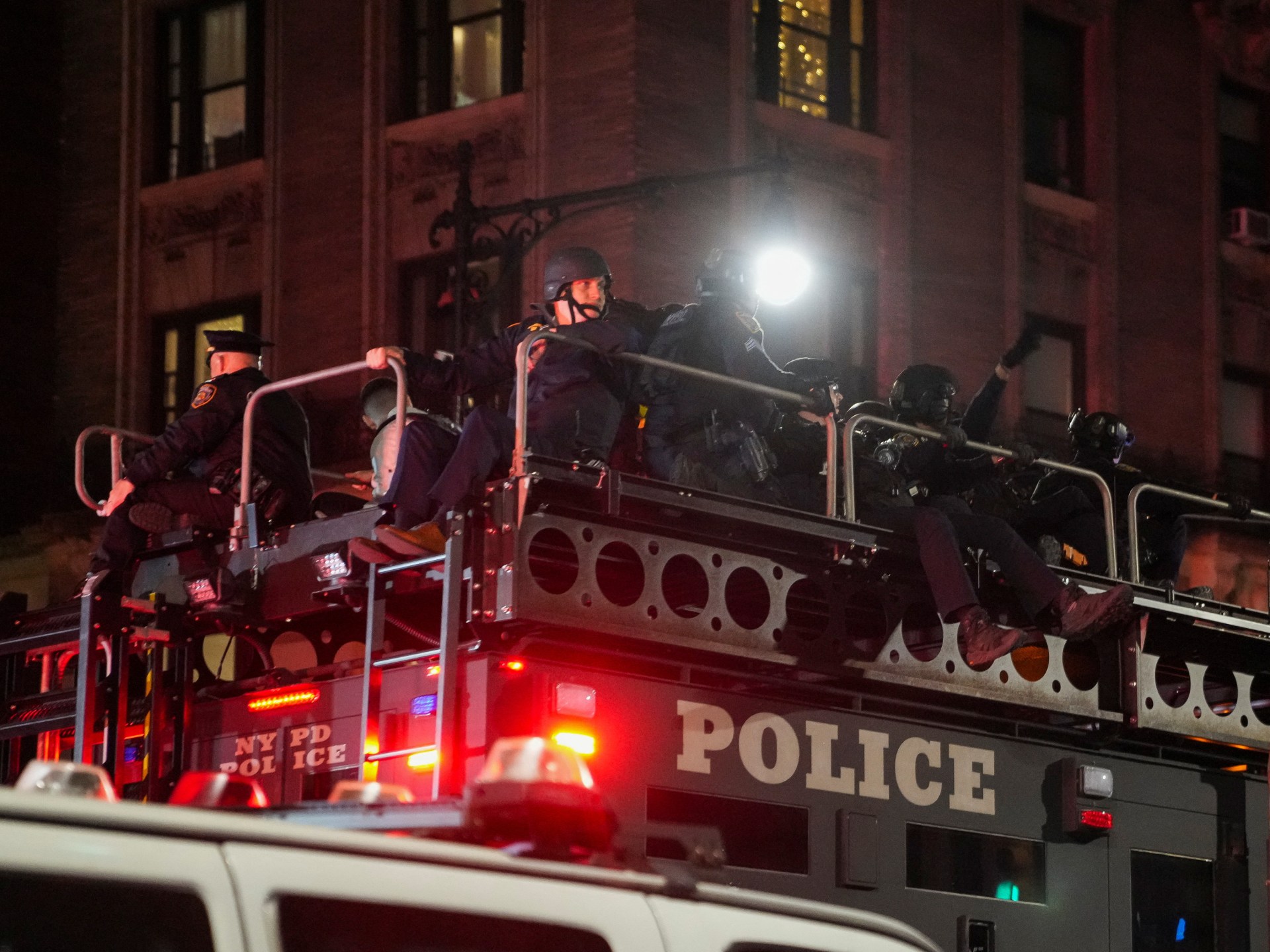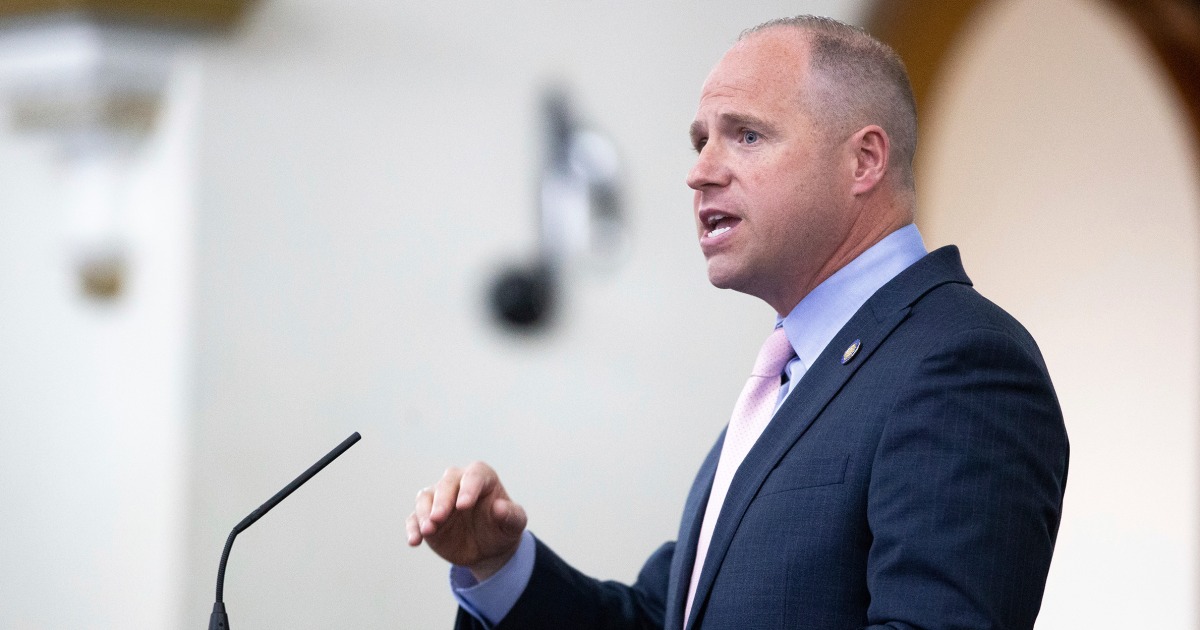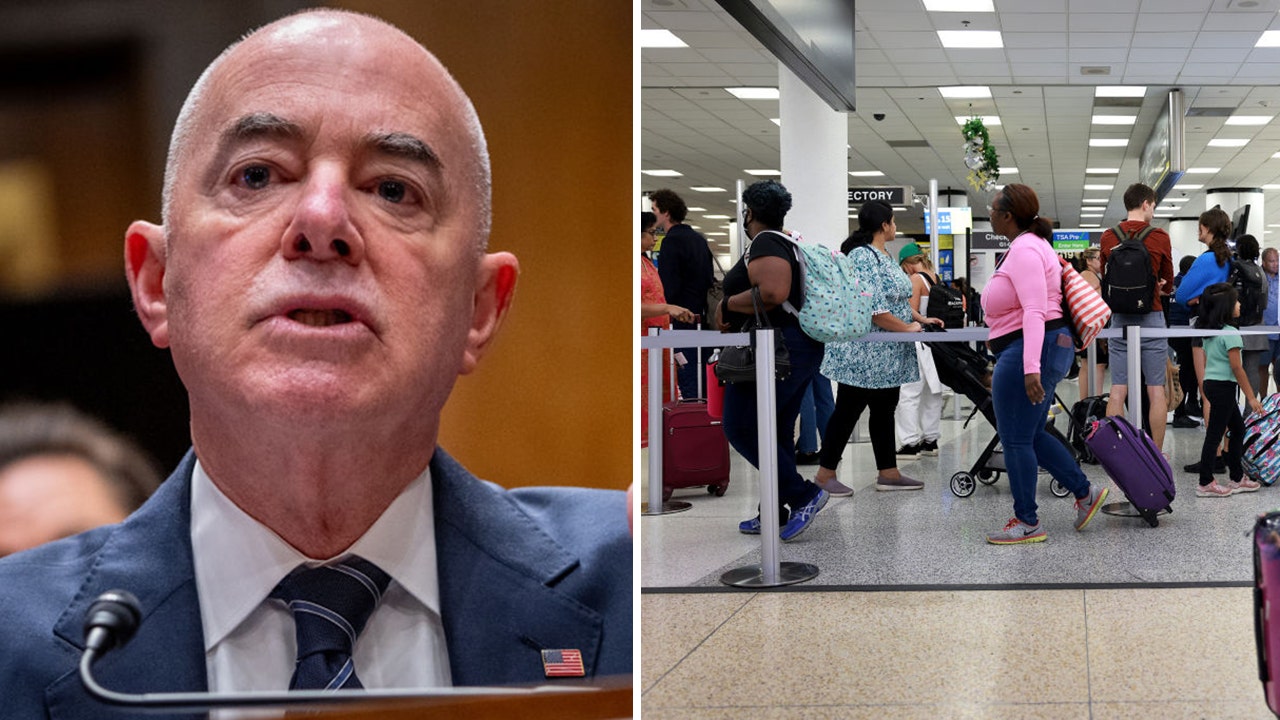Rhode Island
Too many cubicles, too few homes spur incentives to convert offices to housing • Rhode Island Current

Read more Stateline coverage of how communities across the country are trying to create more affordable housing.
HERNDON, Va. — Juan Ramirez, watching his dog play in Chandon Park here in suburban Virginia on a Saturday morning, tries to imagine the massive office buildings next to the park becoming apartments and townhouses.
“I guess it’s inevitable. People don’t use offices as much now. I hope it’s affordable. Maybe it’ll bring more young people to town, more taxes for parks,” said Ramirez, 38, who grew up in the area and returned recently to take a restaurant management job after living in Minnesota and Ohio.
Cities and suburbs around the country are struggling with vacant office space as remote work becomes an established post-pandemic reality. States are stepping in with tax breaks and zoning changes to help replace the unwanted cubicle farms with much-needed housing. In suburbs such as Herndon, the answer might be tearing down an office complex and replacing it with a residential building. In more urban environments it might mean renovating and retrofitting office buildings to create apartments.
“Office vacancy has climbed to a 30-year high and at the same time there’s a housing shortage. So naturally the question is, ‘Why can we not convert all these vacant office buildings into housing?’” said Jessica Morin, research director for CBRE, a commercial real estate firm. CBRE research shows converting offices to other uses, mostly housing, is set to peak this year at more than 20 million square feet, up from 6.3 million in 2021.
Some places that started conversions before the pandemic are leading the way: New York state and New York City changed their laws during a 1990s downturn to allow more office-to-apartment conversions in Manhattan, although now there’s a state vs. city standoff on zoning rules to convert newer offices.
Ohio, where interest in city living grew when Cleveland spruced up its downtown for the 2016 Republican convention, now has three cities — Cleveland, Cincinnati and Columbus — in the top 15 list for office conversions to housing, according to CBRE.
Nationwide, 119 office conversion projects, including for residential and other use, are under construction or were completed this year, the most since CBRE began tracking them in 2016. Those projects could add about 44,000 new housing units when completed.
Since 2016, projects representing 125 million square feet of offices have or are slated to be converted to other uses, usually to housing but sometimes to warehouses or laboratories. But despite the recent increase, that represents only about 2% of all U.S. office space.
Impediments to making apartments out of offices include the still-high value of office buildings in some downtown areas in cities such as San Francisco, and the cost of demolishing or refitting old office buildings with plumbing for individual kitchens and bathrooms. Many office buildings also lack windows with natural light, which apartment-dwellers often demand.
That’s why state incentives have played a large part, as well as streamlined zoning that makes project costs more predictable for developers. Some states are further along than others. A new California law allows residential “building by right” in office and other commercial zones, meaning developers don’t have to petition for a zoning change. Washington state passed a law last year requiring cities to ease zoning requirements for housing in existing commercial buildings. And an Arizona bill signed into law this month will allow larger cities to convert more commercial buildings into housing without zoning changes.
Predictable zoning rules are important to developers who don’t want to get bogged down in negotiations and refusals that could sink a project.
“Developers just urge their states and localities to be really transparent, streamline the process, make the unknowns limited, because it’s the unknowns that drive risks,” said Julie Whelan, a vice president at CBRE. “Otherwise, they’re going to go look at the next pasture.”
Incentive programs
In addition to the Ohio cities, Chicago; Dallas/Fort Worth; Houston; Hartford and Fairfield County in Connecticut; the Kansas City metro area; Louisville, Kentucky; Minneapolis/St. Paul; Pittsburgh; Milwaukee; New Jersey; and Washington, D.C., are on CBRE’s top 15 list for rate of office space converted to apartments.
Ohio has two incentive programs for office conversion to housing. A 2020 program for “transformational” projects that could spur further development helped convert four floors of offices to apartments under construction at Playhouse Square in Cleveland. A historic building preservation incentive in place since 2007 helped partly convert Carew Tower in Cincinnati to apartments, said Mason Waldvogel, a spokesperson for the Ohio Department of Development.
Missouri is hoping to replicate that success in St. Louis, where about a quarter of the commercial space, including offices, is vacant. That includes the massive 44-story One AT&T Building downtown, with almost 1.5 million square feet, that sold for $3.6 million this month, compared with $205 million in 2006.
Missouri state Sen. Steven Roberts, a Democrat who represents the downtown St. Louis area, said a bill he’s sponsoring has bipartisan support from suburban Republicans, and is aimed at creating downtown areas in St. Louis and elsewhere where people can live, shop and eat as well as work. The bill was voted out of committee in February and is awaiting consideration by the full Senate.
The bill would create a state tax credit for up to 30% of the cost of converting office space to housing, retail or other uses.
“It’s a creative workaround to make downtown more vibrant and successful. We want to get more restaurants, more stores, more nightlife — and the way to do that is to get more people living there,” said Roberts. “It’s an issue for downtown and also for the whole state.”
Other states have enacted laws to encourage more conversion of offices to housing, according to a Minneapolis Federal Reserve Bank report last year. Laws passed by Florida and Montana in 2023 allow new and converted multifamily housing in commercial areas, and laws in Rhode Island and Wisconsin support conversion of existing commercial and office buildings.
A Colorado bill now in committee would provide tax credits for commercial conversion to housing starting in 2026, supporting Denver’s plans to transition its office-oriented Central Business District to a “Central Neighborhood District.” Denver identified 16 commercial buildings as prime candidates for housing.
Zoning changes
Starting in the mid-1990s, a combination of state and city laws helped transform lower Manhattan’s business district with more apartments, a process that accelerated after 9/11. A proposal by Democratic Gov. Kathy Hochul to expand the program to newer buildings failed to pass the legislature as part of a broader measure that included requirements for suburban and upstate communities to build more housing. Negotiations are continuing with lawmakers to make the change for New York City this year.
When you have a 20% office vacancy rate and a 1.4% rental apartment vacancy rate, it makes a lot of sense to substitute one for the other.
– Casey Berkovitz, spokesperson for the New York City Department of City Planning
New York City also has begun working on its own rules to allow office-to-housing conversions citywide for buildings built before 1990, said Casey Berkovitz, spokesperson for the Department of City Planning. The state could do it faster and could also create tax incentives that the city cannot create on its own, and that’s also part of current negotiations with the state legislature, Berkovitz said.
“When you have a 20% office vacancy rate and a 1.4% rental apartment vacancy rate, it makes a lot of sense to substitute one for the other,” Berkovitz said. “We don’t want our own regulations standing in the way of that if it makes financial sense.”
In Herndon, town officials last month approved a zoning change that would clear the way for demolition of the Worldgate Drive offices and the construction of a combination of rental apartments, townhouses and “two over two” units with accessory living areas an owner can rent out or share with family members. All apartments would be market rate without subsidized affordable units, Ken Wire, an attorney for the developer, Boston Properties, said at last month’s hearing on the zoning change.
“We believe that by providing more housing in the area, we are adding to the overall supply, which thereby reduces price pressures in the market,” Wire said.

Virginia considered two state Senate bills this session that would have created incentives to convert offices to apartments but neither has passed, said Allison Brown, policy associate for the nonprofit Virginia Housing Alliance. One would have created a state income tax credit for office-to-residential conversion, and another would have allowed more residential building in commercial areas if they included affordable housing.
The Worldgate Drive housing plan may spur Herndon to change its zoning rules to allow similar projects without zoning changes, said Elizabeth Gilleran, the town’s director of community development.
Herndon wants to “retain its sense of community and historic small-town feel” but also keep a strong commercial tax base that has helped support the town’s tax coffers when home values inevitably rise and fall, Gilleran said. The town recently approved conversion of a small office park and a hotel to homes. But offices and other commercial buildings will remain a key component of the town’s suburban building mix as density grows with a recent new commuter rail stop that opened in 2022.
“The town doesn’t wish to become a bedroom community,” Gilleran said.
Stateline is part of States Newsroom, a nonprofit news network supported by grants and a coalition of donors as a 501c(3) public charity. Stateline maintains editorial independence. Contact Editor Scott S. Greenberger for questions: [email protected]. Follow Stateline on Facebook and Twitter.
GET THE MORNING HEADLINES DELIVERED TO YOUR INBOX

Rhode Island
Parents tote toddlers to D.C. to press for expanded child tax credit, child care funds • Rhode Island Current

WASHINGTON — Families gathered outside the U.S. Capitol Tuesday to “make a fuss for babies,” who they believe are being left behind by lawmakers who direct only a fraction of U.S. resources to young children.
Parents and kids representing 50 states and the District of Columbia convened for the eighth annual “Strolling Thunder.” Moms and dads pushing strollers decked out in state license plates rallied on the Capitol’s East Lawn to lobby lawmakers to fund child care, establish national paid family leave, and permanently expand the child tax credit.
Matthew Melmed, executive director of ZERO TO THREE, the organization behind the event, rallied parents to tell their representatives that the 11 million babies in the U.S. “make up 3.4% of our population, but 100% of our future.”
“You’re here with the pork producers and the insurance lobby and the pharmaceutical industry. Members of Congress don’t normally see real people, and they rarely see babies and toddlers, particularly babies and toddlers who need to have their diapers changed on their desks. And that’s what I encourage you to do if you need to have that happen,” Melmed told the crowd.
The nonprofit ZERO TO THREE bases its advocacy on health and developmental research findings in infants up to age 3, the years the group describes as “the most important for lifelong mental health and well-being.”
Melmed praised top Democratic appropriators Sen. Patty Murray of Washington and Rep. Rosa DeLauro of Connecticut for achieving a $1 billion increase for child care block grants and Head Start in this year’s government funding bills.
DeLauro, who spoke to the crowd, said “families deserve better.”
“The cost of living has increased year after year, and more and more Americans simply do not get paid enough to live on, let alone to raise a family,” the Connecticut lawmaker said, promising to advocate for the reinstatement of a fully refundable child tax credit.
‘Diapers, child care, formula’
Candace Winkler, a former Alaska resident and current ZERO TO THREE leader, sat on the Capitol lawn next to Sabrina Donnellan who traveled to D.C. from Girdwood, Alaska, with her 13-month-old Blakely to advocate for lower child care costs and paid family leave.
Winkler, the organization’s chief development and strategy officer, said the group of families would divide up in the halls of Congress Tuesday to meet with their representatives about six key policy issues, including permanently expanding the child tax credit to pandemic levels.
“We’ve seen that time and time again that families are using those resources for diapers, child care, formula and things their babies and their family needs. And it’s really critical for their success,” WInkler said.
The current child tax credit is $2,000 a year after tax liability, but the amount a parent could receive per child under 17 in a refund check is capped at $1,600 in 2023. The credit phases in at 15% on every dollar after earnings of $2,500.
As the U.S. was digging out from under the COVID-19 economic crisis, Congress approved a one-year expansion of the tax credit to $3,000 per child under age 18, and $3,600 for those under age 6 — including for families who made $0 in income. Lawmakers made the entire amount refundable, and a portion of it was sent to families in monthly installments.
Advocates hailed the research findings that showed the temporary move was a game changer for lifting children from poverty in the U.S.
A current bipartisan proposal, widely supported by U.S. House lawmakers, to temporarily expand the child tax credit until 2025 — though not to pandemic levels — is currently stalled by U.S. Senate Republicans who liken aspects of the bill to a welfare program.
The proposal, as passed by the House, would increase the credit’s refundable portion to $1,800 in 2023, $1,900 in 2024 and $2,000 in 2025. The legislation would also increase the phase-in rate to 15% per child, simultaneously — in other words, 30% for a family with two children, 45% for a family with three, and so on.
Credit card debt for child care
Cruz Bueno, a parent from Warwick, Rhode Island, shared her story of racking up credit card debt to enroll her 11-month-old Rosie in child care, along with her 2-year-old sister Amalia.
“Putting Rosie into daycare means that we must put a halt to our dream of buying a home,” said Bueno, an economist who lives in Warwick with her husband, Xhuljan Meta.
“One of the stipulations of our mortgage pre-approval was to keep our credit card balances low. Even so, we remain hopeful that one day in the not-so-distant future we will be able to buy a home to raise our girls and pass on wealth to them,” she said.
When asked about the Strolling Thunder event at Tuesday morning’s regularly scheduled House Republican press conference, House Speaker Mike Johnson of Louisiana said, “There’s lots of ideas out there. What we stand for, what our party stands for, is support of families. We support infants and children, and there’s an appropriate role to play in that.”
“The devil’s always in the details on legislation, so I’m not sure exactly what they’re proposing, but all of us are looking at those avenues. We want to support families. That’s good public policy,” Johnson said. “In our view, the best way often for the government to do that is to step back and allow the local and state officials to handle their business at that local level.”
Rep. Elise Stefanik, House Republican Conference Chair, said the GOP is “proud to be a pro-family conference.”
“There are many of our members who have proposed innovative solutions — one is rural child care. Home-based child care, that’s an issue I’ve worked with many of my colleagues on the Education and Workforce Committee,” Stefanik, of New York, said. “But the economy, the border, crime, these issues, these crises caused by Joe Biden, they impact every family.”
GET THE MORNING HEADLINES DELIVERED TO YOUR INBOX
Rhode Island
R.I.’s lawyers warn Washington Bridge contractors about possible lawsuit – The Boston Globe

“Failure to preserve this information could have serious consequences,” Wistow wrote.
Wistow and attorney Jonathan Savage are in the process of investigating who might be at fault for the bridge’s failure, declaring earlier this month it was “open season” on any potential defendants.
The letter also invites each company to inspect the bridge — under supervision ― before it is demolished, taking with it any evidence that the companies might want to use in their defense.
“While that investigation proceeds, efforts are already underway to stabilize the bridge (so that it does not catastrophically collapse) and, eventually, to demolish and replace it,” Wistow wrote. “Those efforts cannot be delayed. … We are inviting you to inspect the bridge now, prior to its demolition.”
The companies have until May 11 to contact the firm to schedule an inspection.
Reached by phone, Wistow said the 12 companies have all either done construction, design or inspection work on the bridge. He said he could not say if these are the only possible defendants in the case, or if there could be others.
“We do not yet know who any defendants will be,” Wistow wrote in the letter. “Therefore, you should not interpret your receipt of this letter to mean that you will be named as a defendant if suit is brought. You may consider it prudent to notify your insurance carrier of this letter.”
The companies that received the letter are AECOM Technical Services, Steere Engineering, PRIME AE Group, Cardi Corporation, Barletta Heavy Division, Aetna Bridge Company, Vanasse Hangen Brustlin, Commonwealth Engineers & Consultants, TranSystems Corporation, Collins Engineers, Michael Baker International, Jacobs Engineering Group.
Six of the firms are based in Rhode Island or Massachusetts.
It’s not immediately clear how long it would take for the companies to inspect the bridge if all of them choose to take the state up on the offer. But Wistow told the Globe the process of allowing potential defendants to inspect it would not delay the demolition.
“We’re not going to sit here and keep it in a pristine condition for you to come and inspect it,” Wistow said.
The Rhode Island Department of Transportation last week put out a call for companies to bid to demolish the bridge, a process that is slated to start in July and end in March 2025.
The DOT on Tuesday separately issued a request for bids to build the new bridge, which is slated to open sometime in 2026.
The westbound span of the Washington Bridge was abruptly shut down on Dec. 11 after an engineer doing work on the bridge flagged a “critical failure.”
The bridge, which used to carry 90,000 cars a day over the Seekonk River to Providence, was initially expected to be repaired and reopened within three months. But new problems were uncovered during inspections, prompting McKee to announce in March that the state will demolish and reconstruct the bridge.
The eastbound span, which is a separate and newer bridge, remains open and is now being used for both eastbound and westbound traffic on I-195.
McKee has promised a “day of reckoning” for anyone involved in the bridge’s failure. The state was in the process of rehabilitating the structure when the failure was discovered.
The lawsuit is focused on contractors that might result in money recouped for the state, but Wistow said if the investigation finds that any Department of Transportation employees were at fault, that would be reported.
“There’d be very little point of suing DOT,” Wistow said. “But if we uncover something about DOT that was inappropriate, we’re going to report it to the proper authorities.”
See more coverage of the Washington Bridge closure in R.I.
Steph Machado can be reached at steph.machado@globe.com. Follow her @StephMachado. Brian Amaral can be reached at brian.amaral@globe.com. Follow him @bamaral44.
Rhode Island
The Independent Man returns for Rhode Island Independence Day | ABC6

PROVIDENCE, R.I. (WLNE) — The Independent Man will be heading back home.
Just in time for the state’s Independence Day, the Independent Man will be returned to public view this Saturday, May 4, from 9:30 a.m. to 2 p.m. as part of a State House open house.
With a new layer of gold leaf, it will be available for viewing during the State House’s regular weekday hours of operation through the summer.
Plans are currently underway to return the Independent Man to the top of the State House this fall, once a replacement marble base, using Georgian marble from the original quarry, is completed.
In a statement, Governor Dan McKee said:
“As promised, I want to make sure that Rhode Islanders have another chance to see the Independent Man up close and experience an exciting part of Rhode Island history before the statue returns to its perch later this year. He has his shine back, and I have to say, he is looking sharp.”
Last fall, the statue was removed after that the marble base of the statue was revealed to be compromised. A team was hired to restore it.
-

 Education1 week ago
Education1 week agoVideo: Dozens of Yale Students Arrested as Campus Protests Spread
-

 World1 week ago
World1 week agoEU sanctions extremist Israeli settlers over violence in the West Bank
-

 Politics1 week ago
Politics1 week agoDemocrats hold major 2024 advantage as House Republicans face further chaos, division
-

 Politics1 week ago
Politics1 week agoFetterman hammers 'a–hole' anti-Israel protesters, slams own party for response to Iranian attack: 'Crazy'
-

 World1 week ago
World1 week agoPeriod poverty still a problem within the EU despite tax breaks
-

 Politics1 week ago
Politics1 week agoA battle over 100 words: Judge tentatively siding with California AG over students' gender identification
-

 Movie Reviews1 week ago
Movie Reviews1 week agoShort Film Review: Wooden Toilet (2023) by Zuni Rinpoche
-

 News1 week ago
News1 week agoUniversal Studios Tram Crashes, 15 Injured, 1 Critical





